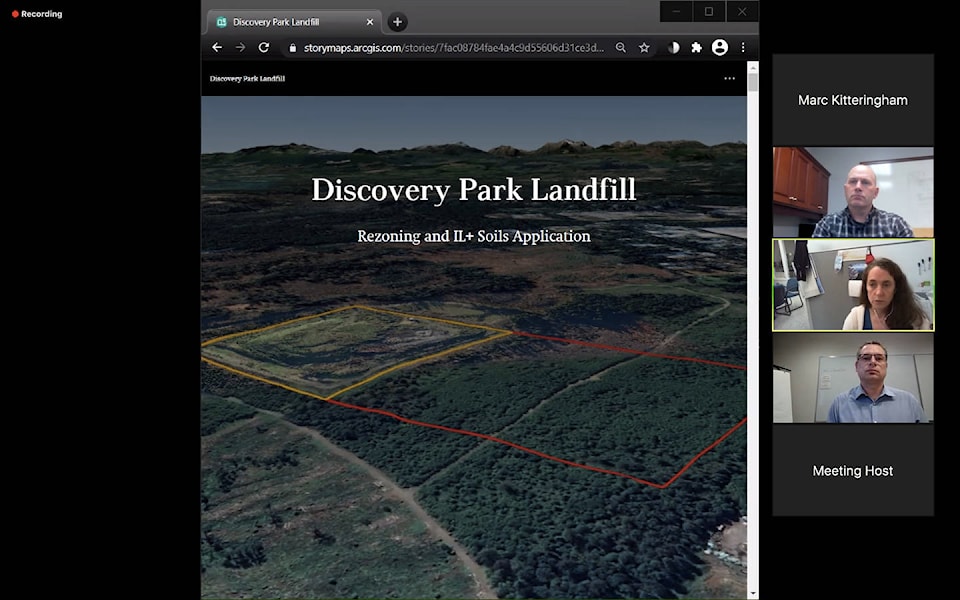Over 70 people tuned in to Zoom on Thursday night (Dec. 10) for an open house on the proposed Discovery Park landfill at the old Elk Falls Mill site.
The meeting was held by Discovery Park, and gave people a chance to ask questions and clarify some of the issues that have arisen. At its peak, 71 people were in attendance and over 50 questions were posed, only one third of which were addressed in the time allotted. Questions that went unanswered were still noted and will be answered in an upcoming newsletter on the project expected within 10 days, according to the meeting organizers.
The meeting started with a description of Discovery Park’s corporate ownership structure. The property was purchased in 2016 from a company called Quicksilver Resources Canada by Rockyview Canada Inc., which was partially owned by Canadian and international investors and a company called Shanghai Energy Corporation (SEC). In 2018, SEC bought out the investors and now owns the entirety of the property.
“SEC made changes to its executive team, and in the fall of 2018 began a $13 million lawsuit against its former executives for fraud and failure of fiduciary duty. The fraud is ongoing and is public record,” said Troy Whittle, project supervisor for the Discovery Park site during the meeting.
The Globe and Mail reported in the fall of 2018 that those executives were Wentao Yang and Kevin Richmond. Yang was also the subject of an investigation and raid by the Canada Revenue Agency in connection with the Panama Papers scandal, CBC reported.
SEC itself is headquartered in Calgary, and operates natural gas and oil resources assets in B.C. and Alberta, with most of its work in B.C. At the top level, SEC is owned by a private Hong Kong-based company and 23 other international companies hold beneficial interest.
“It’s also worth knowing that SEC and its affiliates are in good financial standing and in compliance with all regulatory bodies,” Whittle said.
The project is a rezoning with the city of Campbell River. The current land is zoned Industrial 2 (I-2), which does not allow landfills. As part of the process, the rezoning will need to go to a public hearing, where people can voice their concerns to the city, which in turn makes the final decision. They are also applying to the Agricultural Land Commission to designate the ALR land as non-farm use.
Discovery Park also applied to change materials accepted in to the landfill. Under the current permit, things like boiler ash, effluent, and other non-salvageable materials are allowed into the landfill. Discovery Park intends on expanding that to include soils contaminated with fuel or chemical spills, from leaks at gas stations and used in the decommissioning and clean up of industrial sites. The landfill will be lined with an impermeable membrane to prevent leaching. Most of the materials are expected to come from Vancouver Island, with some being barged in from the Lower Mainland.
“The landfill will not accept any material that could be considered municipal solid waste, toxic materials or hazardous waste,” said Sue Durnin, Project Manager with Terrawest Environmental, the company who drafted the design, operation and closure plan of the proposed landfill.
This will ensure the smell is kept down and will keep scavengers out of the area, the proponents say.
According to Durnin, the impact on wildlife will be minimal. A 2006 impact study done on the herd of elk living in the area showed that they were, “habituated to the activities” happening in the area and are expected to be “habituated” to expanded activities.
“They did not seem bothered by any of the activities going on in the landfill including any noise,” Durnin explained. “The impacts are expected to be low in magnitude and limited in extent.”
The presentation portion of the event concluded with remarks on the operational details of the landfill, and with some technical details of the construction and maintenance of the site.
After the presentation, the speakers took questions. Most questions were about the landfill’s operation, including the volume of the site, any remediation plans and environmental concerns from neighbours. Some technical details were not available at the time of the presentation, but would be provided in the follow-up newsletter.
One question touched on the public notification process. The audience member, who was not named in the presentation, asked why the residents of Campbell River were not all notified of this project. Kevin Brooks, a senior planner with McElhanney Ltd. responded saying that the City of Campbell River’s notification process is to let properties within a 100 metre buffer know about any rezoning projects. McElhanney planners increased that buffer to 500 metres to ensure everyone directly impacted by the project were aware of it.
Brooks also confirmed that there would be a public hearing for the project, where city council will hear from members of the public who wish to speak about the project.
The newsletter, which will include a copy of the presentation, will be sent to all attendees around 10 days after the meeting.
RELATED: Residents concerned about north Campbell River landfill project
Discovery Park to hold open house about landfill project
marc.kitteringham@campbellrivermirror.com
Like us on Facebook and follow us on Twitter
